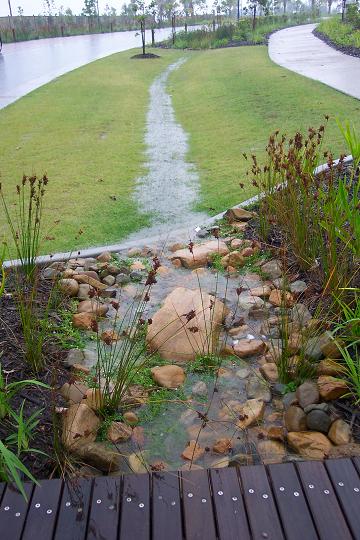|
|
|
Project 3: Adoption Tools
Key Messages
Building Industry Capacity for Biofilters- Adoption of Technologies
A central aim of FAWB was to promote the widespread adoption of biofilter technologies.
With technologies such as biofilters being adopted as mainstream practice, industry capacity needs to be improved.
FAWB aimed to build industry capacity for biofilter technologies by delivering a number of products and services to industry:
Biofilter application, Coomera Waters
Modelling Tools
- Algorithms for improved prediction of the performance of biofilters including bioretention systems and constructed wetlands
Anticipated outputs:
- A simple, but robust, design model of biofilter performance
- Biofilter design methodology for a number of possible situations (e.g. residential sites, retrofit, rain gardens, highway runoff treatment, re-use, etc)
Adoption Guidelines
- Design recommendations for multi-functional biofilter systems
- Design and construction guidelines for biofilter systems
Key outputs:
- a set of design recommendations outlining the principal design considerations needed for effective operation of biofilters for water quality improvement.
- production of guidelines
The guidelines should assist industry to adapt biofilter technologies into urban design for multiple functions. Typical examples could include urban design amenities, and treatment for stormwater reuse. Other novel designs may arise during the research.
- Results from the Technology, and Demonstration and Testing, projects demonstrate that the filter media type has a strong influence on pollutant removal and that the wrong filter media can result in leaching of pollutants. FAWB has thus revised its guidelines for soil filter media to provide clear guidance for specifying filter media properties to ensure hydraulic and treatment function.
- Pollutant removal by biofiltration systems is primarily determined by the filter media type and the presence and type of vegetation. Modelling of treatment performance will therefore be relatively simple and, in many cases, lookup tables are adequate for predicting their pollutant removal performance.
- Results from the Technology, Policy and Risk, and Demonstration and Testing, projects are currently being synthesized in the form of guidelines for the design and adoption of stormwater biofiltration systems. These guidelines will include chapters addressing planning, technical design, construction, maintenance and monitoring.
Project 1 | Project 2 | Project 3 | Project 4
|
